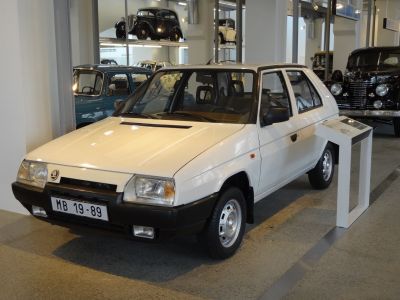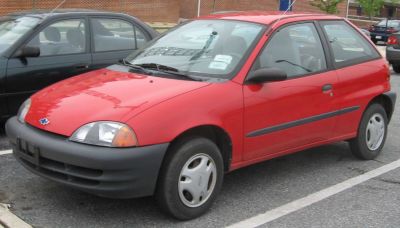 1981 Volkswagen Polo II (86C) Dimensions, Size & Specs
1981 Volkswagen Polo II (86C) Dimensions, Size & SpecsMeasurements of the 1981 Volkswagen Polo II, engineered for optimal performance and comfort
| Dimensions | |
|---|---|
| Length: | 3765 mm148.2 in12.4 ft |
| Width: | 1570 mm61.8 in5.2 ft |
| Height: | 1350 mm53.1 in4.4 ft |
| Trunk Capacity: | 240 liter8.5 cu ft |
| Trunk Capacity (Max): | 1030 liter36.4 cu ft |
| Weight Specifications | |
| Curb Weight: | 765-830 kg1687-1830 lbs |
| Maximal permitted Weight: | 1230-1250 kg2712-2756 lbs |
| Tire Specifications | |
| Rims Sizes: | 13-inch rims:
|
| Tire Size: |
|
The Volkswagen Polo II (86C) is a quintessential compact hatchback that marked its presence in the automotive market from 1981 to 1994. Designed with practicality and city-friendly dimensions in mind, this hatchback offers a length of 3765 mm (148.2 inches), a width of 1570 mm (61.8 inches), and a height of 1350 mm (53.1 inches), making it an ideal choice for urban driving and tight parking spaces. The Polo II’s curb weight ranges between 765 to 830 kg (1687 to 1830 lbs), with a maximum permissible weight varying from 1230 to 1250 kg (2712 to 2756 lbs), reflecting its lightweight design geared towards fuel efficiency and agile handling.
Under its compact exterior, the Polo II features a surprisingly versatile luggage capacity of 240 liters (8.5 cubic feet) with the rear seats positioned normally, which can be remarkably expanded to 1030 liters (36.4 cubic feet) when the rear seats are folded down, ideal for larger cargo or travel needs. Equipped with 13-inch rims (4.5J x 13) and narrow 155/70 R13 tires, the Polo II blends maneuverability with functional efficiency, embodying the characteristics of an economical yet reliable small car of its era.
This generation of the Polo represents Volkswagen's commitment to offering a compact, comfortable, and efficient hatchback for drivers seeking a practical vehicle without compromising quality. Its dimensions and weight make it easy to handle, while the extended luggage space ensures versatility beyond just daily commuting. As one of Volkswagen’s iconic models, the Polo II (86C) remains relevant for enthusiasts and those interested in the history of compact cars, particularly in the hatchback segment.
Discover the standout features that make the 1981 Volkswagen Polo II a leader in its class
Have a question? Please check our knowledgebase first.
The Volkswagen Polo II (86C), produced between 1981 and 1994, has a length of 3765 mm (148.2 inches), a width of 1570 mm (61.8 inches), and a height of 1350 mm (53.1 inches). These compact dimensions reflect its hatchback design, emphasizing maneuverability and suitability for urban environments. The relatively low height contributes to a lowered center of gravity, enhancing driving stability. Its width supports comfortable seating for passengers, while the overall size makes it easy to navigate tight spaces and park in urban settings.
The Volkswagen Polo II (86C) has a curb weight ranging from 765 kg to 830 kg (1,687 to 1,830 lbs), depending on the trim and equipment level. The maximum permissible weight ranges between 1230 kg and 1250 kg (2,713 to 2,756 lbs). The curb weight represents the weight of the vehicle with standard equipment, fluids, and without passengers or cargo, while the maximum weight indicates the total allowable weight including passengers and cargo. This lightweight design contributes to fuel efficiency and agile handling.
The luggage capacity of the Volkswagen Polo II is 240 liters (8.5 cubic feet) with the rear seats in the upright position, providing sufficient storage for daily errands or small trips. When the rear seats are folded down, the cargo space expands significantly to 1030 liters (36.4 cubic feet), allowing for the transport of larger items or increased luggage volume. This versatility in cargo space makes the Polo II practical for various usage scenarios, from city driving to small family outings.
Yes, the Volkswagen Polo II (86C) fits comfortably into a standard residential garage. Given its compact length of 3765 mm (12.35 feet), width of 1570 mm (5.15 feet), and height of 1350 mm (4.43 feet), it is well-suited for typical garage spaces that generally start at around 2400 mm (7.87 feet) width and 4800 mm (15.75 feet) depth. This makes parking and storage convenient for owners without requiring specialized accommodations.
Compared to the Volkswagen Polo I, the Polo II (86C) offered a slight increase in dimensions for improved interior space and comfort. The Polo I was shorter and narrower, with a length around 3700 mm (145.7 inches) and narrower width, which resulted in less cabin and cargo space. The Polo II's length at 3765 mm (148.2 inches) and width of 1570 mm (61.8 inches) allowed for better passenger accommodation and a more spacious feel, addressing the growing consumer demand for small but practical hatchbacks. This generational step helped improve usability and the overall driving experience.
The Volkswagen Polo II (86C) was competitive in size against contemporaries such as the Ford Fiesta Mk1 and the Opel Corsa A. Its length of 3765 mm (148.2 inches) and width of 1570 mm (61.8 inches) placed it slightly larger than some rivals, offering improved interior space without sacrificing maneuverability. For example, the Ford Fiesta Mk1 measured about 3600 mm (141.7 inches) in length, making the Polo II slightly longer, thus providing increased passenger comfort and cargo capacity. This sizing enabled Volkswagen to balance ease of city driving with practical usability.
The Volkswagen Polo II was equipped with rim sizes of 13 inches, specifically 4.5J x 13. The standard tire size corresponding to these rims was 155/70 R13. These relatively narrow tires and smaller rims were typical for compact hatchbacks of the early 1980s, focusing on fuel efficiency, comfort, and good road handling on urban roads. The combination helped maintain a smooth ride and reasonable grip while keeping replacement and maintenance costs low for owners.
Yes, the Volkswagen Polo II (86C) is highly suitable for city driving. Its compact length of 3765 mm (148.2 inches), narrow width of 1570 mm (61.8 inches), and relatively light curb weight between 765 and 830 kg (1,687 to 1,830 lbs) enable nimble handling and easy maneuverability through tight urban streets and congested traffic. These dimensions support ease of parking in small spaces, while the modest size contributes to fuel efficiency and lower running costs, making the Polo II an ideal urban hatchback during its production years.
The Volkswagen Polo II (86C) was praised for offering a comfortable interior with efficient use of space relative to its compact external dimensions. While its length was modest at 3765 mm (148.2 inches), the hatchback design and clever interior packaging afforded adequate legroom and headroom for both front and rear passengers, making it practical for small families or commuters. Compared to many competitors, it balanced passenger comfort with cargo flexibility, especially thanks to the folding rear seats and the expanded cargo capacity of up to 1030 liters (36.4 cubic feet).
The Volkswagen Polo II (86C) was produced over a notably long period from 1981 to 1994, which allowed for several incremental updates to its design and features. While the core compact hatchback shape remained consistent, Volkswagen introduced various facelifts and engine improvements throughout its lifecycle to keep the car competitive. The extended production run is a testament to the Polo II's popularity and versatility, combining compact dimensions with practical performance to appeal to a wide range of customers during the 1980s and early 1990s.
Discover similar sized cars.

| Production: | 1989-1994 |
|---|---|
| Model Year: | 1990 |
| Length: | 3815 mm150.2 in |
| Width: | 1620 mm63.8 in |
| Height: | 1415 mm55.7 in |

| Production: | 1998-2007 |
|---|---|
| Model Year: | 1998 |
| Length: | 3790 mm149.2 in |
| Width: | 1590 mm62.6 in |
| Height: | 1390 mm54.7 in |
